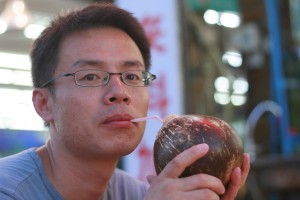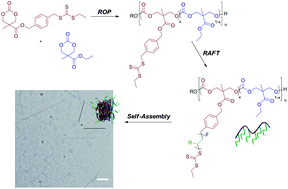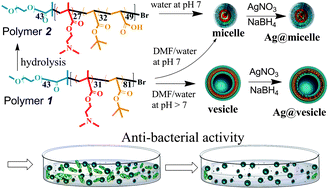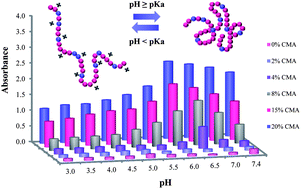 Zesheng An obtained his BS and MS degrees from Shandong University in 1997 and 2000, respectively. He then went to the University of Arizona to pursue his PhD degree and spent three years there from 2000 to 2003. After moving to Georgia Institute of Technology and spending two years from 2003 to 2005, he got his PhD in Chemistry with Prof. Seth R. Marder. His PhD thesis was focused on the synthesis and characterization of organic semiconductors, especially discotic liquid crystals with high charge-carrier mobility, for applications in optoelectronics. From 2005 to 2008, he was a postdoc at the University of California, Santa Barbara with Prof. Galen D. Stucky and Prof. Craig J. Hawker, working on the synthesis of polymer nanoparticles. In 2008, he joined the Institute of Nanochemistry and Nanobiology, Shanghai University, where he is now a Professor of Special Appointment (Eastern Scholar) at Shanghai Institutions of Higher Learning. His current research is focused on RAFT heterogeneous polymerization in water, which in turn serves as a platform for designing interesting materials such as nanogels and core cross-linked star polymers. Applications of these materials in emulsion and biotechnology are being investigated within the group and through collaboration with other groups within the Institute.
Zesheng An obtained his BS and MS degrees from Shandong University in 1997 and 2000, respectively. He then went to the University of Arizona to pursue his PhD degree and spent three years there from 2000 to 2003. After moving to Georgia Institute of Technology and spending two years from 2003 to 2005, he got his PhD in Chemistry with Prof. Seth R. Marder. His PhD thesis was focused on the synthesis and characterization of organic semiconductors, especially discotic liquid crystals with high charge-carrier mobility, for applications in optoelectronics. From 2005 to 2008, he was a postdoc at the University of California, Santa Barbara with Prof. Galen D. Stucky and Prof. Craig J. Hawker, working on the synthesis of polymer nanoparticles. In 2008, he joined the Institute of Nanochemistry and Nanobiology, Shanghai University, where he is now a Professor of Special Appointment (Eastern Scholar) at Shanghai Institutions of Higher Learning. His current research is focused on RAFT heterogeneous polymerization in water, which in turn serves as a platform for designing interesting materials such as nanogels and core cross-linked star polymers. Applications of these materials in emulsion and biotechnology are being investigated within the group and through collaboration with other groups within the Institute.
What was your inspiration in becoming a chemist?
I have to confess that I was very much interested and did pretty well in chemistry in high school, it was however not until I met Prof. Marder at the University of Arizona that I decided to make a career out of it. Indeed, Prof. Marder was and has always been a successful career model for me.
What was the motivation to write your Polymer Chemistry article? (DOI:10.1039/C2PY20442H)
RAFT polymerization has become mature and has been widely used in the synthesis of well-defined polymers. Over the past several years, RAFT polymerization in heterogeneous polymerization media, especially in water, has witnessed significant development, which often combines polymerization and self-assembly of the produced polymers in the same system. This polymerization-induced self-assembly process has been used for the synthesis of colloids of various morphologies such as spheres, fibers and vesicles. Significantly, not only the synthesized polymers are controlled by RAFT, but also can the nano-objects of various morphologies be synthesized at high solid content (>10%). We have exploited such polymerization-induced self-assembly process to synthesize core cross-linked star (CCS) polymers via both RAFT emulsion and dispersion polymerization (Chem. Commun. 2011, 47, 12685-12687; 2012, 48, 7389-7391). This robust strategy features high concentration, high efficiency, high star yield and high star quality. In the current work, we directly polymerized polyPEGMA in aqueous solution up to complete monomer conversion and used it as the arm without separation/purification to synthesize CCS in RAFT heterogeneous polymerization in water. We also investigated the effect of various parameters on the formation of CCS.
Why did you choose Polymer Chemistry to publish your work?
Number one, Polymer Chemistry publishes high quality papers in my research area, so it is a nice place to publish my own work. Number two, through the submission experience of my previous paper published in Polymer Chemistry, I highly appreciate the way that the editors handle the review process, being highly efficient and with great fairness. Number three, Polymer Chemistry is becoming one of the leading journals in polymer science, so it is exciting to publish papers in such an excellent journal.
In which upcoming conferences may our readers meet you?
Well, I do not have plans to attend any conference at the moment. I guess I will attend more conferences in the following years.
How do you spend your spare times?
I used to play soccer but quit after an injury of my tibia. Now, I am trying to spend more time with my family, making dinner, playing Go with my daughter, walking my dog…
Which profession would you choose if you were not a scientist?
Aha, I have not realized anything that I could do better than making polymers. If I were not a scientist, I guess I might end up as a journalist.


















